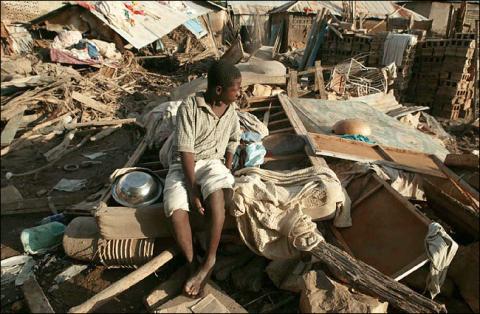Media choose sensation over insight in Haiti reportage

If Haiti was visited by an “apocalypse” or “Dantean” horror in the aftermath of the earthquake of January 12, then there was one news story that perfectly captured it.
The streets of Port-au-Prince, the devastated capital, were littered with roadblocks made of corpses. Earthquake survivors, out of either anger or trauma, or perhaps Caribbean voodoo superstition, had piled bodies high across the streets, in protest at their neglect.
[A version of this article first appeared on www.prospectmagazine.co.uk]
The story made headlines around the world. Oddly, though, for such a visceral image, the headlines didn’t appear to be accompanied by photos of the scene.
Still more oddly, then, the story was attributed to a photographer, Time Magazine’s Shaul Schwarz. Schwarz had told a Reuters reporter he had seen two such roadblocks on his travels across the city, and Reuters sent the story global.
By the time the story reached the London Independent, it had acquired the further authority of being attributed to (nameless, but apparently numerous) “eyewitnesses”, rather than to a solitary photographer. Many papers distorted Schwarz’s comments to give the impression of these roadblocks being widespread, even as Schwarz himself was telling the BBC that he had seen one such roadblock, and hoped it might have been a “once-off”.
The story fostered the impression of a city reverting to savagery in response to the savagery of nature visited upon it.
(If that impression seems familiar, think back to the stories of another natural disaster visited upon largely black, urban population, Hurricane Katrina. Then, when refugees filled New Orleans’s Superdome football stadium, there were widespread reports of mass murders, rapes and beatings taking place in the huge, improvised shelter. When the stadium was finally evacuated, the total number of deaths reported was six, none of them violent.)
That reversion to savagery was a common theme, particularly in the early reporting from Haiti, as news organisations sent crisis reporters – many of them with war-reporting experience – to cover the quake’s aftermath.
“Looting” quickly became a main story. “Haiti teetered on the brink of total anarchy tonight as looters rampaged through the streets of Port- au-Prince,” wrote the Daily Mail. There were dramatic photos and footage of fights between “looters”, with some showing Haitian forces with guns, or looters armed with rocks or machetes.
There was one telling background detail in many of these images, however: ordinary people passing by, apparently undisturbed by the looting, often women walking by with goods for sale balanced on their heads (as is common in many poor countries). These told a different story: that behind the headlines of violent anarchy, normal life was attempting to reassert itself. The United Nations humanitarian coordination agency, OCHA, reported midweek that fruit and vegetable traders were returning to the streets of Port-au-Prince, and pharmacies and barbershops were opening. By this weekend, banks had reopened, giving Haitians access to their savings.
Irish readers should be particularly sensitive to hyped-up accounts of looting: Clery’s was looted during the Easter Rising, but were some historian to suggest today that this were of comparable significance to the facts of the Rising itself, they would be readily derided.
There were other anomalies and inadequacies in the reporting from Haiti. The US military was prominent in news reports: footage of heavily armed soldiers distributing bottles of water, of airdrops of food, and of US helicopters landing in front of the ruined presidential palace, was widely used to accompany reports on the humanitarian response. These efforts may have been laudable, but they paled in comparison to those of the United Nations and charities on the ground in Haiti. The UN’s World Food Programme said it had distributed three million meals to 200,000 people by late this week, and estimated that a further 100,000 people had been fed by charities.
There were plans to scale this up to reach two million people, with four key distribution sites identified. By contrast, the US Southern Command reportedly made two air drops during the week of some 17,000 meals each.
Of course, some of the most prominent stories in the days since the quake have been good news stories: those remarkable images of people being pulled alive from the rubble by international search and rescue teams. Dozens of teams from all around the world helped rescue over 120 people. Yet even this creates a misleading impression. As anyone who has worked in a crisis zone knows (I spent two years in Angola, working on emergency relief programmes), the most important “rapid response” always comes from the people themselves. Early footage after the quake showed ordinary Haitians desperately sifting through rubble, searching for, and no doubt rescuing, family and neighbours – their successes, though, remained uncounted and largely unreported.
The media is a vital part of the response to any crisis such as this, and there has been much outstanding reporting coming out of Haiti; Twitter, meanwhile, has proved valuable for getting some sense of the voice of ordinary Haitians. But too often, reporters and their editors have led with glib headlines and poorly sourced information. The courage of those on the ground deserves more.
